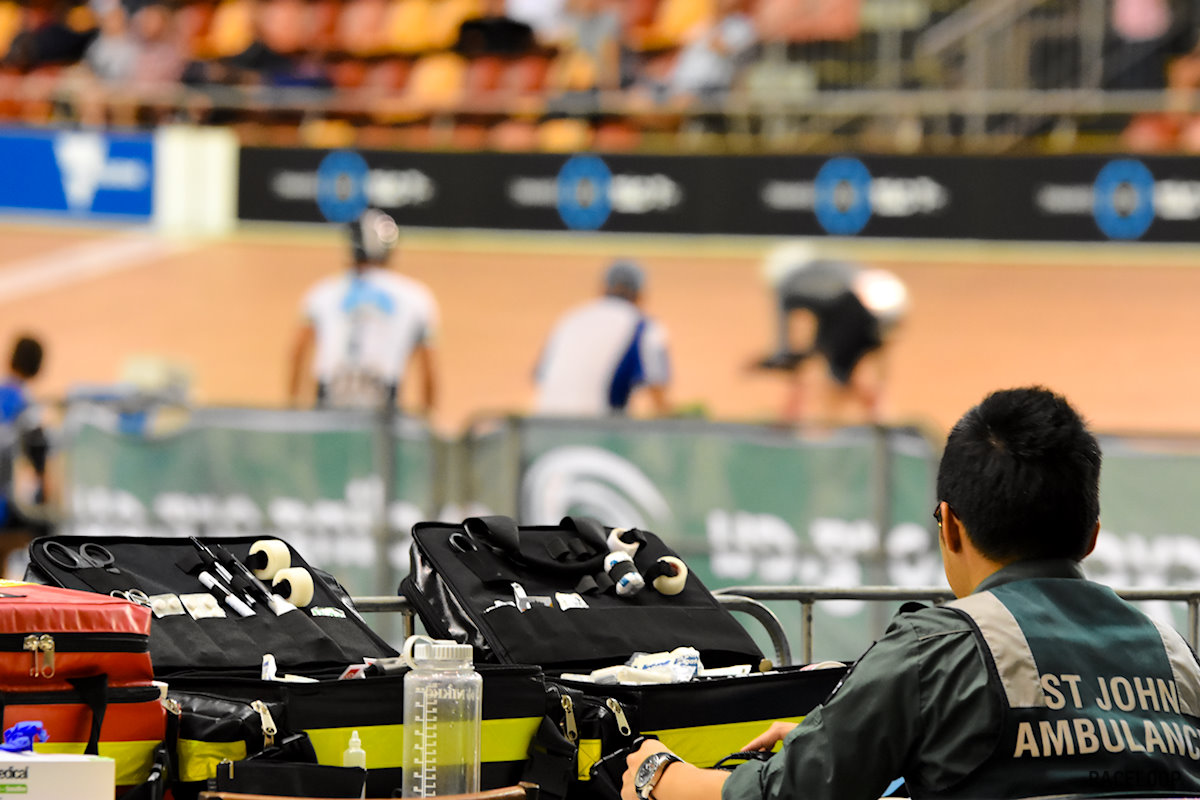Part 5: Track Event Risk Management
Other articles & resources in this series can be found here.
This is the fifth and final article in this series on how to run your track event. This topic has been left until last as it is probably the most important part of the series. Although much of it comes down to common sense it makes sense to discuss it as it impacts rider enjoyment & safety, event operations, your ability to attract sponsorship and whether or not you can receive insurance & sanctioning.
When organising any (track) cycling activity the organiser must be aware of the associated risks. There is no escaping that track cycling will present certain risks however they should be understood as best as possible and eliminated or minimised as much as possible to create a safe and enjoyable environment for all. As an event organiser you will need to take positive action to eliminate and reduce the likelihood of accidents, by identifying, evaluating and responding to risks before accidents occur. This process is called Safety and Risk Management.
Although each event is different and each event will have different resources available there are a number of characteristics which will be common between events. When assessing the risks of your event all you’re basically doing is considering what can go wrong, how it could impact the safety of the participants, spectators and staff, and how you will deal with the risk so your event will be able to continue according to plan. Importantly, as a race organiser you have a duty of care to the people attending your event to ensure they are safe so risk management is largely about planning for how to deal with potential problems in the most appropriate way. The bottom line is that race directors need to recognise that risk management is an integral part of good event management practice.
Categorising Risk
Before you can start working out how your event could be exposed to the various risks it is worth discussing the four broad categories of risk that you will be dealing with. Having this foundation will give a solid starting point from which you can start devising any sort of risk management strategy.
| Risk | Comments |
| Known knowns | Known knowns are the risks we know that we know and these risks are the easiest risks to plan for. You know they can happen and what they mean for the event. For example, bad weather or if the Chief Commissaire doesn’t turn up. |
| Known unknowns | These are a little harder to plan for as these are things we know that we don’t know, or we don’t know their potential risks. Although you don’t know the magnitude of the impact of the risk, you can create a plan that will cover the majority of scenarios. For example, you can rider crashing. |
| Unknown knowns | These are things that exist and have been influencing our life and our approach to reality, but we are unaware of knowing them, or we do not realize their value, or worst we refuse to acknowledge knowing them. |
| Unknown Unknowns | Unknown unknowns are the worst kind of risks; we don’t even know that we don’t know they exist and they can hit us with serious unexpected impacts. In some instances, one side may see a risk as known unknown, but the other side maybe completely unaware of it, an unknown unknown. |
Thankfully, the nature of track racing means there are far fewer elements to consider when devising your event. Track events are obviously conducted on closed circuit, off road courses which afford a decent level of control of the surrounding space. Ordinarily there is no need to consider aspects such as traffic management, disruption to local business, corner marshalling, and all the other variables that go into making a successful road racing event.
The risk management plan
A risk can mean many things but for the purposes of your event the main risks to consider are anything that could:
- cause harm to another person
- cause damage to equipment, infrastructure or the event site, or
- harm the future of the event organisers and event itself.
Of course many risks will be out of your control. In this case it is important that the risk management plan details who is responsible for coordinating the safety of every person should something that is out of the control of the event organiser occur.
For club level events, an organiser would use the sponsoring club’s risk management plan/strategy. For larger events where you may be required to produce a seperate plan as per the requirements of the sanctioning body. For track events, it may be appropriate to use an existing plan from another event whilst simply adding the specifics of your event.
Risk management plans identify the potential risks that may arise during an event and then they list the steps that will be taken to reduce or mitigate the identified risks. That is, they are plans for how you will deal with mishaps/disasters at the event. Broadly, there are four potential strategies, with numerous variations.
As an organiser you may choose to:
| Risk Action | Notes |
| Avoid | Change plans to circumvent the problem. |
| Control/Mitigate | Reduces impact or likelihood (or both) through intermediate steps. For example, in the event of a crash, first aid will be in attendance to assist. |
| Accept | Take the chance of negative impact. Either financially or otherwise. |
| Transfer | Outsource risk using an insurance policy. |
Although this seems complex and convoluted, it’s actually quite straight forward. This is especially true for track events where the risks tend to be the same from event to event. A simple yet effective way to document this is by using a risk matrix.
As you start running more events, your plan should be continually reviewed and evaluated. This will require monitoring records, accident reports and losses. As the event organiser it is good practice to communicate the new findings relevant to the risk management plan to all involved in the running the club. This is what helps make your work sustainable beyond your own personal efforts.
Risk Classification
Armed with theoretical starting point for understanding the relevant risks presented earlier, you can start classifying event risks. Risks must be assembled and dealt with in priority order. Commissaires may choose to analyse and classify risks according to the following table.
| Risk Classification | Examples |
| High | Frequent accidents with severe consequences and the strategy should be to avoid such risks. |
| Moderate | Infrequent accidents with major loss and the strategy may be to take out insurance. |
| Moderate | Frequent accidents with minor loss and the strategy may be to manage the risk. |
| Low | Infrequent accidents with minor injury and the strategy may be to accept the risk. |
Once risks have been identified and assessed it is good practice to implement an appropriate risk reduction campaign. Risk reduction may lower the frequency and severity of accidents and injuries, and may even help maintain or reduce insurance premiums payable.
Risk matrix
As part of your risk management plan, an effective way to communicate how your have identified the risks and how you will deal with them is by creating a risk matrix. This is simply a table which lists the risks associated with the event and the necessary actions used to deal with them.
The risk table below will help you create a detailed and systematic way of documenting how your intend to conduct your event in terms of when things go wrong.
| Action | Notes |
| Risk Evaluation |
|
| Defining the risk |
|
| Risk identification |
|
| Evaluate the Risk |
|
| Is the risk acceptable or unacceptable |
|
| Treat the Risk |
|
| Monitor and Review |
|
Download this Sample Risk Matrix to help you get started. Note, this example is just a sample and it must be adapted to your specific event.
The roles of commissaires and first-aid
After documenting your event, it is important to know that commissaires play a critical role in the management of risk on event day because a) they are responsible for supervising and controlling a cycling competition and b) they have undertaken formal training (including a risk management component) to fulfil this role.
In the weeks leading up to the event it is important to engage with the Chief Commissaire that you have chosen for your event so that they are aware of your plans. You do not want any surprises on event day such as the chief telling you that there are safety issues that need to be fixed before racing can commence. Involve the chief early and let them help you ensure your event is safe.
First aid responders (such as St Johns or a qualified first aid responder) is not a substitute for a paramedic. First aid is responsible for ensuring that any injured participant is dealt with in the most appropriate way. If a paramedic is called to the event they will need good, unhindered access to all those involved.
It goes without saying that it is preferable that the First Aid officer is not competing in the event and is contactable and accessible throughout the event. First-aid provides an important role in terms of ensuring the participants are safe so ensure this is done properly.
Conclusion
This final article has given you the final building block from which you can starting creating your event. The articles have purposely been left open ended as each event is different. However, it should provide the basic building blocks from which you can build upon to make a safe and enjoyable event. It’s not hard to do but it will require some thought. It’s not something to be taken lightly but at the same time, as the organiser you can not plan for every single eventuality.
As a series of articles, this final article wraps everything up and it should provide the cornerstone for
your events. Although some of these topics in the series have been dry and somewhat long winded I have tried to present a practical template that can be used for creating a quality track cycling event. My reason for writing the articles is that I have not found anywhere else which has presented first hand experience of how to put things together. I have been very fortunate to have worked for a peak cycling body which has given me experience of running state, national and UCI level events. This is not to mention the track cycling events run through Momnium.
Talk with other event organisers, your chosen chief commissaire and with the first aid staff. Engage them early so that you can start planning properly from the start. Further, if you are planning to run an event, please feel free to reach out and make contact with us here at Momnium. We want to encourage people wherever they are to run more track races. Go for it!
Any questions, comments or corrections? Join in and comment below.
Other articles & resources in this series can be found here.
Share this content:



